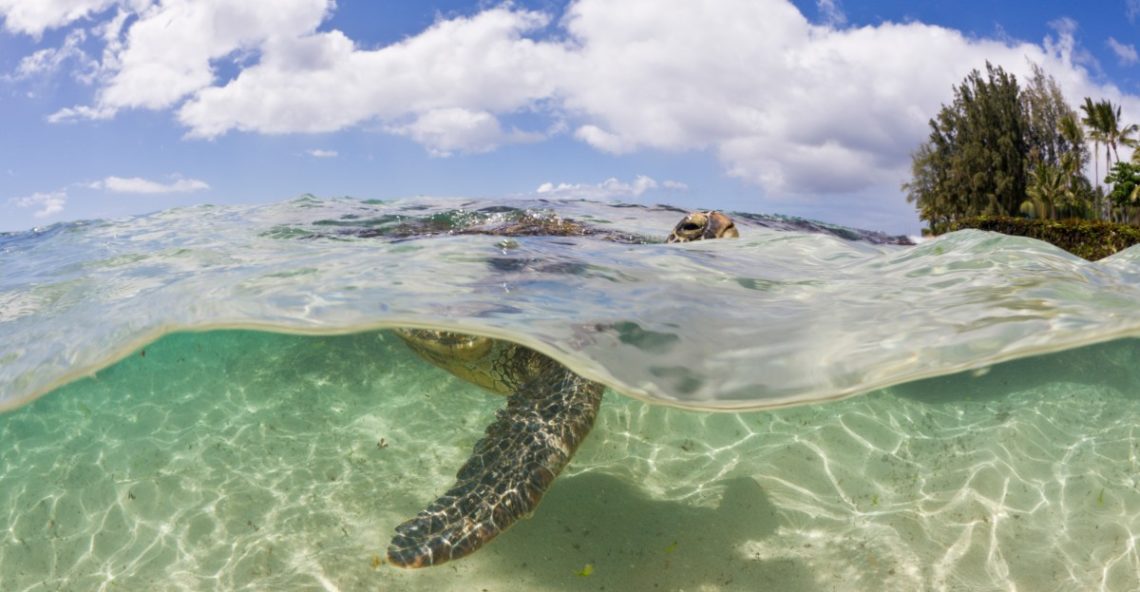Scientists who study wildlife are often the bearers of bad news — this species or that is headed for extinction for the usual reasons, like deforestation or climate change. Just last week, for example, I wrote about new science showing that two valuable coral species in Florida were mostly killed off by global warming.
But earlier this month, researchers announced something overwhelmingly positive: Green sea turtles, the iconic marine species made famous by Finding Nemo that were once at risk of extinction, have bounced back. Dramatically.
According to researchers at the International Union for Conservation of Nature and Natural Resources (IUCN), the leading authority on endangered species, the global population of green sea turtles — one of the seven sea turtle species found worldwide — is up 28 percent since the 1970s. IUCN reclassified the sea turtles from “endangered” to “least concern,” a category reserved for species that are not threatened with extinction and plentiful in the wild.
Scientists measure sea turtle populations by counting their nests on beaches. And in some regions, such as Florida, the number of them has surged in recent years. In the 1980s, for example, researchers detected only around 40 nests each year in and around Archie Carr National Wildlife Refuge, a protected area along Florida’s east coast. Now, they’re consistently counting more than 20,000 of them, said Kate Mansfield, a professor at the University of Central Florida who runs the monitoring program. “The green turtles have just gone absolutely, wonderfully, exponentially higher,” Mansfield told me. “I’m cautiously optimistic.”
What’s so remarkable about the recovery is that it shows conservation efforts can actually work, said Nicolas Pilcher, a sea turtle expert. These animals didn’t recover by sheer chance, said Pilcher, who formerly co-chaired the group at IUCN that determines the status of marine turtles. Their population boom followed decades of projects to minimize threats, including by restricting certain kinds of fishing gear and turning nesting beaches into protected parks. “We can do this, we can save a species,” said Pilcher, who also runs a nonprofit in Malaysia called the Marine Research Foundation.
But there are a few glaring caveats with what is otherwise great news. For one, the recovery of green turtles is not even across the planet. At the largest nesting beach in the Western Hemisphere, located in Costa Rica, the number of green sea turtle nests is plummeting, indicating that these animals still face serious threats. Plus, sea turtles live long lives, in some cases reaching 70 or more years old. That means scientists need to see these trends sustained for years to come to truly show that greens have recovered, Mansfield said.
When conservation actually works
Until recently — and still today, in many places — the biggest threat to green sea turtles was the consumption of turtle meat. These iconic marine reptiles were actually a popular food in the US through the early 20th century, according to food writer and historian Becky Diamond.
“Since just one turtle could feed quite a crowd (some weighed over three hundred pounds), turtle soup was frequently the featured dish on inn menus and at large feasts or festivals,” Diamond wrote in 2018. “Demand for turtle was so high that hosts would advertise these upcoming events in the city’s newspapers and sometimes even sell tickets in advance.”
But even as consumption of sea turtles waned in some countries — in part because the animals became rare and thus harder to find — other human actions continued to erode their population. Sea turtles would get caught in fishing nets, for example, and eventually drown. The construction of hotels, fancy homes, and other buildings along coastlines, meanwhile, destroyed nesting grounds and polluted them with artificial light. (Nighttime lights tend to disorient sea turtles and their hatchlings, making it harder for them to navigate and avoid danger.)
By the late 1900s, these threats had nearly wiped out green sea turtles, earning them federal protection in the US under the Endangered Species Act in 1978. A few years later, IUCN listed them as endangered globally.
Since then, however, the US government and a number of large conservation organizations — which tend to be especially focused on big, charismatic species — jumped into high gear to save green sea turtles. And their efforts apparently paid off.
There were three main conservation approaches that worked, experts told me, starting with simply protecting the beaches where green sea turtles nest. Florida’s Archie Carr National Wildlife Refuge is a good example. The federal government established the refuge in 1991, which limited human development along the coast and the light pollution that comes with it. That means sea turtles can use beaches in the refuge without much disturbance. Many other nesting beaches in the North Atlantic are similarly protected, Mansfield says.
Another effective approach has focused on the commercial fishing industry, especially in the US. Thousands of sea turtles are accidentally caught each year by trawls and other fishing nets that target seafood, such as shrimp. And while sea turtles can hold their breath for several hours, they still might drown if they can’t escape. To solve this problem, scientists and fishermen developed modifications for trawl nets — known as turtle excluder devices — that give large marine animals a way out. At the same time, regulations in the US required that fishermen use circle hooks instead of J hooks for line fishing in some regions. Circle hooks are harder for turtles to fit in their mouths and swallow.
The third approach sought to limit turtle poaching for meat, still common in parts of Asia, Central America, and Africa. Often, the people who harvest turtles are simply trying to make a living. And so, what’s worked to lower hunting in these communities, Pilcher says, is when organizations provide them with an alternative source of income. In Fiji, for example, people who once collected sea turtle eggs to eat or sell are now enlisted by a conservation NGO to protect them. “They go from being the people who are eating the turtles to the people who are conserving the turtles,” Pilcher said.
Why haven’t other turtles recovered?
Not everyone was thrilled with the announcement that green sea turtles are no longer endangered. “I don’t like it,” said Roldán Valverde, a sea turtle researcher at the University of Texas Rio Grande Valley.
The takeaway that these species have recovered overshadows a much bleaker picture in one of his key research areas: Tortuguero, a national park along the northern Caribbean coast of Costa Rica. Tortuguero is the world’s second-largest nesting beach for green sea turtles and the largest in the Western Hemisphere, he said, where researchers used to consistently count more than 100,000 nests each year. Since 2010, the turtle population has quickly declined, dipping below 50,000 nests in recent years.
The decline is linked to the harvest of sea turtles and their eggs elsewhere in Central America, especially in nearby Nicaragua, said Valverde, who is also the scientific director at a nonprofit called the Sea Turtle Conservancy. People have hunted green sea turtles in Nicaragua for generations, he said, but in the past, their fishing gear was more rustic: boats without motors, for example, and harpoons instead of nets. That meant they caught fewer animals. Now, equipped with more advanced gear, they’re able to collect a larger number of sea turtles. And while harvesting turtles is illegal in most cases, officials don’t adequately enforce the law. “The impact is significant and now beginning to show in Tortuguero,” Valverde said.
This is to say: Not all green turtles are doing well.
Neither are other kinds of sea turtles, for that matter. The six other species — from leatherback to hawksbill — are vulnerable to extinction or critically endangered. That raises an important question: Why haven’t they recovered, too?
“That’s something that keeps me up at night,” Mansfield told me, adding that the answer isn’t clear.
Pilcher suspects it’s partly luck. Many of the beaches that green sea turtles nest on happen to be in countries with stronger governance and more funding for conservation, like the US and Australia. Those places tend to afford more effective protection to wildlife.
“You go somewhere like Australia — places where the legal infrastructure is strong, robust, enforced — and those populations are massive and they have a massive impact on the overall survival of the species,” Pilcher said.
Certain sea turtle species, like the leatherback, also spend more time wandering out at sea, Pilcher said, which could leave them more exposed to fishing.
Regardless, this shows that the same threats that once nearly wiped out green sea turtles are still present today. And there are newer, complex threats, too, like plastic pollution. Millions of tons of plastic waste end up in the ocean each year — bags, bottles, food wrappers, etc. — which turtles sometime mistake for food or eat accidentally. Consuming plastic can kill them.
“Instead of chomping down on a squid or a crab, they’re chomping down on a chunk of plastic,” Pilcher said. “We’re finding many turtles that have dozens of pieces of plastic in them. That’s probably going to emerge as a major challenge in the coming years.”
Conservation successes are tenuous. Animals can be relieved of one threat only to be driven towards extinction by another. By the early 20th century, for example, the North Atlantic right whale was nearly extinct from hunting. Yet now, long after people stopped killing them for their baleen and blubber, new threats, such as ship strikes and ropes from crab and lobster fishing, are jeopardizing their existence — a reminder that the job of protecting species is never really finished.
The post This beloved animal is back from the brink of extinction — with one big caveat appeared first on Vox.




